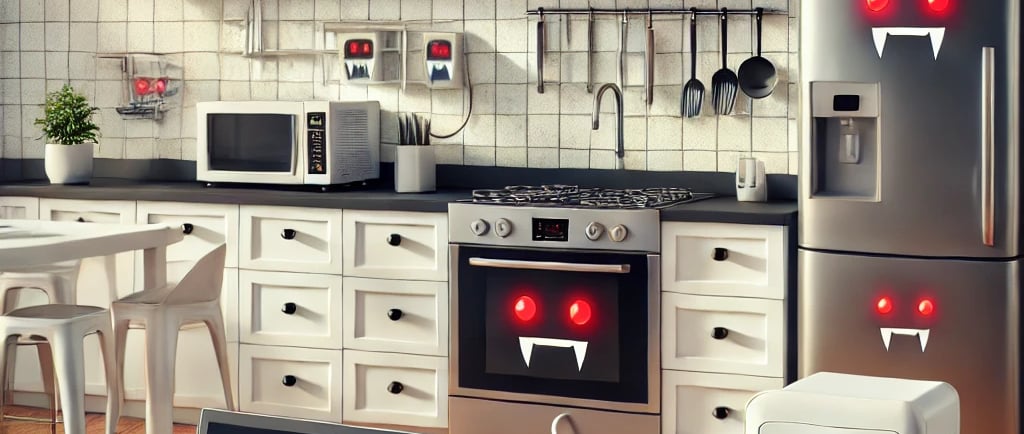How to Identify and Fix Vampire Appliances: Save Energy and Cut Your Bills
Do you ever wonder why your electricity bill is higher than expected—even when most of your appliances are turned off? You might be dealing with “vampire appliances” – devices that continue to draw power in standby mode. In this guide, we’ll explain what vampire appliances are, show you how to spot them, and provide practical repair and energy-saving tips to reduce wasted power and save money.
3/9/20252 min read


How to Identify and Fix Vampire Appliances: Save Energy and Cut Your Bills
Introduction
Do you ever wonder why your electricity bill is higher than expected—even when most of your appliances are turned off? You might be dealing with “vampire appliances” – devices that continue to draw power in standby mode. In this guide, we’ll explain what vampire appliances are, show you how to spot them, and provide practical repair and energy-saving tips to reduce wasted power and save money.
Table of Contents
1. Overview of Vampire Appliances
2. Common Causes of Energy Drain
3. How to Identify Vampire Appliances
Check Your Power Meter
List Common Off-Mode Devices
Compare Energy Usage
4. Practical Fixes and Prevention Tips
5. Tools and Resources
6. Conclusion & Call-to-Action
7. Technical Optimizations
1. Overview of Vampire Appliances
"Vampire appliances" are devices that continue to consume electricity even when they appear to be off or are in standby mode. Common culprits include chargers, televisions, cable boxes, microwaves, and even some kitchen appliances. This “phantom” power draw can add up to significant energy waste and cost—sometimes up to $440 or more annually.
2. Common Causes of Energy Drain
Understanding why appliances continue to draw power is the first step in addressing the problem. Some key factors include:
Standby Mode: Many modern devices remain partially active to receive remote signals or update information.
Internal Clocks and Displays: Digital clocks, LED displays, or internal timers can draw continuous power.
Always-On Sensors: Appliances with motion or temperature sensors may remain powered to monitor their environment.
3. How to Identify Vampire Appliances
Identifying these energy suckers is easier than you might think. Follow these steps:
Step 1: Check Your Power Meter
Use a plug-in power meter or a smart plug with energy monitoring to measure the power consumption of individual devices when they are turned off. This will help pinpoint which appliances are drawing significant power.
Step 2: List Common Off-Mode Devices
Make a list of all devices that remain plugged in even when not in active use—think chargers, TVs, gaming consoles, and kitchen gadgets.
Step 3: Compare Energy Usage
Compare the readings from your power meter with the device specifications. If you notice unexpected energy consumption, that device might be a vampire appliance.
4. Practical Fixes and Prevention Tips
Once you’ve identified vampire appliances, take these steps to reduce their energy consumption:
Use Smart Power Strips: These automatically cut off power when devices are not in use.
Unplug Devices: Unplug chargers, remote controls, or other devices when they’re not actively needed.
Enable Power-Saving Modes: Many modern appliances have settings to reduce energy consumption—make sure these are activated.
Invest in Energy-Efficient Models: When replacing old devices, choose models that meet Energy Star or similar energy efficiency standards.
Regular Maintenance: Keep your appliances clean and well-maintained, as dust and aging components can lead to increased power usage.
5. Tools and Resources
To effectively manage and reduce vampire appliance energy usage, consider these tools and resources:
Plug-in Power Meters: Devices like the Kill-A-Watt measure power consumption in real time.
Smart Power Strips: Automatically cut off power to devices in standby mode.
Energy Monitoring Apps: Many smart plugs and home energy monitors come with apps that track your usage over time.
Government and Utility Resources: Check local utility websites for tips on reducing phantom power consumption.
6. Conclusion and Call-to-Action
Vampire appliances can quietly drain your wallet and contribute to unnecessary energy waste. By identifying these devices and taking simple, practical steps—such as using smart power strips, unplugging when not in use, and enabling power-saving modes—you can significantly reduce your energy bills and help protect the environment.
If you found these tips helpful, please share your experience in the comments below and subscribe to our newsletter for more expert appliance repair guides and energy-saving tips!. You
Fixmyhive - DIY
Step-by-step guides for home appliance repairs.
About Us | DIY Guides | Tools & Resources | Blog | Contact
© 2024. All rights reserved.
